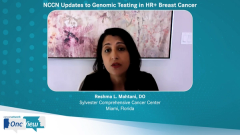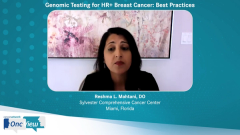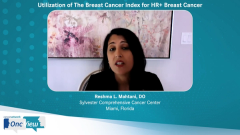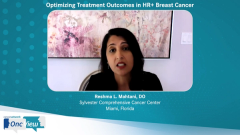
NCCN Guideline Updates for the Use of Genomic Assays in HR+ Breast Cancer
A review of NCCN-recommended genomic assays and their impact on the management of HR+ breast cancer.
Episodes in this series

Kristie Kahl: What’s the significance of the recent guideline update in regard to the use of genomic assays in hormone receptor–positive breast cancer?
Vijayakrishna Gadi, MD, PhD: When I talk to my colleagues who practice in the community, who see a variety of diseases—not just breast cancer, as I tend to do—I find that the NCCN [National Comprehensive Cancer Network] Guidelines are the most influential thing. Not only are the payers using them, but so are the physicians, and patients can look them up for themselves. They are the guidelines for not only the United States but the world. I can go to India, China, Malaysia—all these places where I have traveled and given lectures—and they hold these guidelines to be sacred.
They’re very influential in our decision-making, and part of it is that you have a large committee looking at all this data in great detail. They’re taking input from their partners and their colleagues, then synthesizing all this complex information and doing the hard work to distill: “What are the real things that we should be focusing on to provide exceptional care for our patients?” The price of admission is high to get on the guidelines, but once you’re on the guidelines, everybody pays attention to what those are. They’re incredibly influential for most of us.
Kristie Kahl: What are the available gene expression assays that are included in the NCCN recommendations, and what does each tell us?
Vijayakrishna Gadi, MD, PhD: In the very early stage and right-after-surgery setting, there are 2 that have what we call level 1 evidence, which derives from properly done, prospective clinical trials that are directly focused on the test. For that, you have the 21-gene test, also known as the Oncotype DX, and you have the 70-gene test, also known as the MammaPrint. Those are the 2 that have that level 1 of evidence. I have my preference for the 2 in different clinical situations, but those are the ones I typically reach for.
The others fall under the category 2, and even then, there’s a 2a and a 2b: 2a means there’s uniform consensus by the committee that this is a test that could be ordered. The only uniform consensus around these tests, and around the BCI [Breast Cancer Index] test, is this test for making decisions around the extended adjuvant setting. The other tests all fall in this 2b category, which means that there is some debate still ongoing. Where the level of data is not at that randomized control prospective level, those fall under a slightly lower threshold. Then there are a variety of tests that do not quite make the guidelines at this time. Maybe 1 day in the future they might.
Transcript edited for clarity.
Newsletter
Stay up to date on recent advances in the multidisciplinary approach to cancer.







































































































